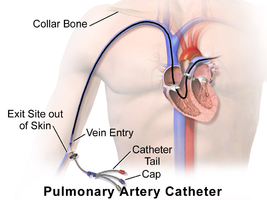Pulmonary artery catheter
Pulmonary artery catheterization (PAC) is the insertion of a catheter into a pulmonary artery. Its purpose is diagnostic; it is used to detect heart failure or sepsis, monitor therapy, and evaluate the effects of drugs. The pulmonary artery catheter allows direct, simultaneous measurement of pressures in the right atrium, right ventricle, pulmonary artery, and the filling pressure (“wedge” pressure) of the left atrium.
The pulmonary artery catheter is frequently referred to as a Swan-Ganz catheter, in honor of its inventors Jeremy Swan and William Ganz, from Cedars-Sinai Medical Center.
Indications
Use of the pulmonary artery catheter (PAC) has been controversial since the late 1980s. Multi-center observational and randomized controlled trials (RCTs) have concluded that PACs fail to decrease mortality. Subsequently, studies have looked for a decline in PAC use that corresponds to the literature and have indeed found that it exists. However, none to date have looked primarily at trends in the aneurysmal subarachnoid hemorrhage (aSAH) population.
A study used the Nationwide Inpatient Sample (NIS) from 2000-2010 to identify trends in PAC use among patients with aSAH. Trend analysis was assessed using a multivariable regression model with a calculation of slope of PAC frequency over time for pre-2005 and post-2005. Trends in mortality and routine discharge were also assessed for the same time period. 363,096 SAH patients were extrapolated using survey weights, of whom 6,988 had a PAC. Over time, PAC use declined, with a significant downward shift in the year 2005. Analyses also showed a decrease in mortality over the same time period.
The results show that PAC use among patients with aSAH decreased from 2000 to 2010. Similar to other studies, the decline appears to be temporally related to RCTs that showed a lack of benefit from PAC. Studies such as these have the potential to influence clinical practice through illumination of shifting opinions and approaches 1).
The safety and efficacy of this device has been debated in the critical care literature now, with some calling for a moratorium on PA catheter use 2).
It is possible that newer technologies may supplant the need for this invasive procedure while allowing close hemodynamic monitoring 3).
Nevertheless, a PA catheter can be considered for:
a) Hunt and Hess (H&H) grade ≥3 (except good grade 3 patients).
Contraindication
Contraindication for MRI.
